The Immunology of Endometritis, and the use of Immunomodulators to Improve Pregnancy Success
October 12, 2021
Posted by
Dr. Carleigh Fedorka, PhD in
Mare Management
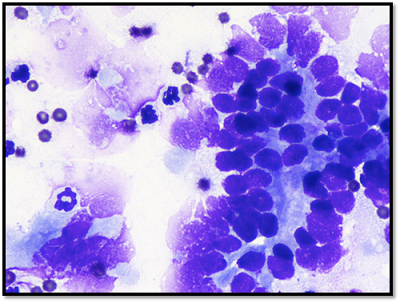 Inflammation and/or infection of the endometrium is the leading cause of subfertility in the horse, with persistent breeding-induced endometritis (PBIE) effecting approximately 10-15% of broodmares [1]. The deposition of spermatozoa, seminal plasma, and/or bacteria into the reproductive tract causes an inflammatory response, leading to an activation of the immune system. This involves an activation of signaling molecules (cytokines), recruitment of immune cells (neutrophils), and eventual release of prostaglandin F2 alpha (PGF2a) from the inflamed endometrium, all of which lead to the eventual expulsion of excess fluid and contaminants [2-10].
Inflammation and/or infection of the endometrium is the leading cause of subfertility in the horse, with persistent breeding-induced endometritis (PBIE) effecting approximately 10-15% of broodmares [1]. The deposition of spermatozoa, seminal plasma, and/or bacteria into the reproductive tract causes an inflammatory response, leading to an activation of the immune system. This involves an activation of signaling molecules (cytokines), recruitment of immune cells (neutrophils), and eventual release of prostaglandin F2 alpha (PGF2a) from the inflamed endometrium, all of which lead to the eventual expulsion of excess fluid and contaminants [2-10].
Management of Twins in the Mare
April 14, 2021
Posted by
Karen Wolfsdorf, DVM Dipl ACT in
Mare Management
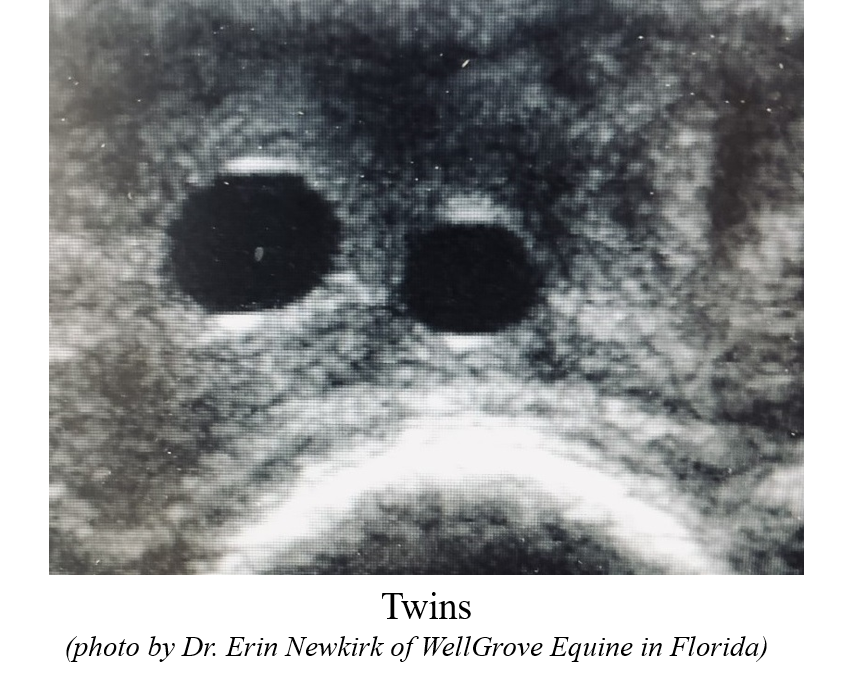 The establishment and loss of twins, often results in a mare that is barren for a year and the associated economic loss. The incidence of twin births has been documented as occurring in 1-2% of the equine population with twinning accounting for 6-30% of abortions in the mare. When twins are present, gestation proceeds normally until the conceptuses begin to compete for uterine space or placenta. With or without mummification, death of one fetus leads to abortion, usually between 5 and 9 months of gestation. Lactation commonly occurs after one foal dies and causes premature mammary gland development. Surviving foals are usually weaker, more susceptible to infection, and slower to develop than singletons. Fortunately, with the use of ultrasound and an increased understanding of the mechanisms involved in twinning, better approaches to twin reduction have been developed.
The establishment and loss of twins, often results in a mare that is barren for a year and the associated economic loss. The incidence of twin births has been documented as occurring in 1-2% of the equine population with twinning accounting for 6-30% of abortions in the mare. When twins are present, gestation proceeds normally until the conceptuses begin to compete for uterine space or placenta. With or without mummification, death of one fetus leads to abortion, usually between 5 and 9 months of gestation. Lactation commonly occurs after one foal dies and causes premature mammary gland development. Surviving foals are usually weaker, more susceptible to infection, and slower to develop than singletons. Fortunately, with the use of ultrasound and an increased understanding of the mechanisms involved in twinning, better approaches to twin reduction have been developed.
Use of Ultrasonography for Pregnancy Diagnosis in the Horse
December 08, 2020
Posted by
Dr. Elena Martinez de Andino in
Mare Management
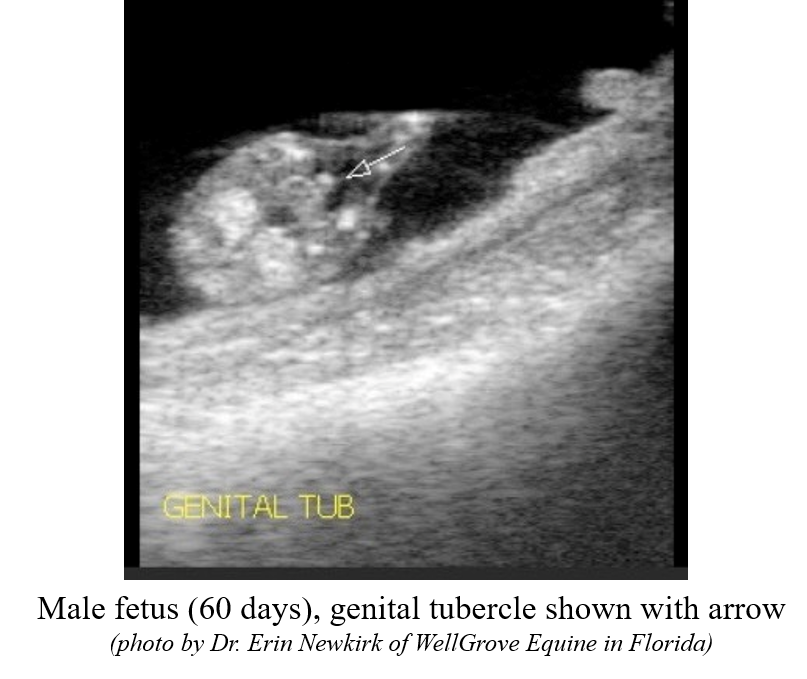 Early detection of pregnancy in mares is strongly demanded by owners in order to maximize breeding efficiency and economic investment. The most reliable and earliest available tool for conceptus detection is ultrasonography. Other diagnostics include palpation per rectum and hormonal blood tests (i.e. estrone sulfate in serum or urine; equine chorionic gonadotropin in serum) as these methods are useful when examination by ultrasound (per rectum or transabdominally) is not possible or feasible.
Early detection of pregnancy in mares is strongly demanded by owners in order to maximize breeding efficiency and economic investment. The most reliable and earliest available tool for conceptus detection is ultrasonography. Other diagnostics include palpation per rectum and hormonal blood tests (i.e. estrone sulfate in serum or urine; equine chorionic gonadotropin in serum) as these methods are useful when examination by ultrasound (per rectum or transabdominally) is not possible or feasible.
Genetic Preservation in Mares Utilizing TVA and ICSI
October 15, 2020
Posted by
Dr. Stephanie Walbornn in
Mare Management
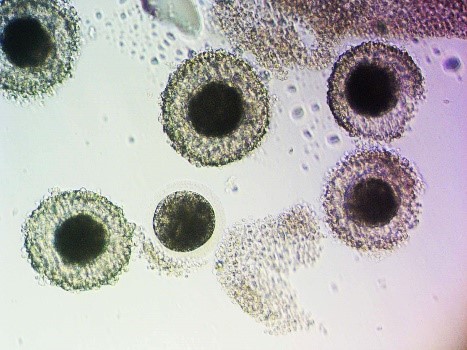 Early demise due to illness or injury can shorten a mare’s reproductive career. Additionally, subfertility can also have a negative impact on a mare’s ability to produce a foal. There have been a multitude of advances in the past 20 years that have allowed for the preservation of genetics in mares. Techniques such as transvaginal ultrasound-guided oocyte aspiration (TVA) and intracytoplasmic sperm injection (ICSI) have allowed us to produce embryos in vitro, circumvent subfertility in mares, and preserve genetics from mares that have died.
Early demise due to illness or injury can shorten a mare’s reproductive career. Additionally, subfertility can also have a negative impact on a mare’s ability to produce a foal. There have been a multitude of advances in the past 20 years that have allowed for the preservation of genetics in mares. Techniques such as transvaginal ultrasound-guided oocyte aspiration (TVA) and intracytoplasmic sperm injection (ICSI) have allowed us to produce embryos in vitro, circumvent subfertility in mares, and preserve genetics from mares that have died.
Breeding Soundness Exam of the Mare
February 11, 2020
Posted by
Dr. Elena Martinez de Andino in
Mare Management
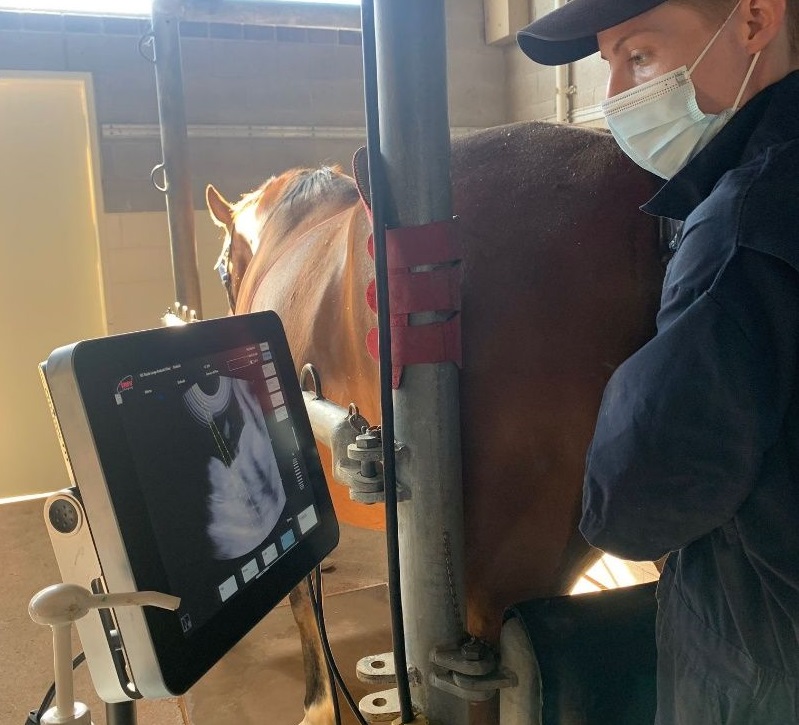 To evaluate a mare's potential for reproductive success or failure, veterinarians often perform a "breeding soundness examination" (BSE). As the breeding season approaches, many owners may opt for a pre-breeding BSE to identify and address any potential reproductive issues prior to breeding. This examination is invaluable for estimating the likelihood of a mare successfully conceiving, carrying a pregnancy to term, and delivering a healthy foal. Pre-breeding examinations are usually performed early in the breeding season when the mare has just begun to cycle or, at the very least, is not in anestrus. Furthermore, the BSE provides veterinarians and owners with important information to determine whether a particular mare should carry a foal herself or whether she might better serve as an embryo or oocyte donor, as well as what breeding strategies are most appropriate for the individual mare.
To evaluate a mare's potential for reproductive success or failure, veterinarians often perform a "breeding soundness examination" (BSE). As the breeding season approaches, many owners may opt for a pre-breeding BSE to identify and address any potential reproductive issues prior to breeding. This examination is invaluable for estimating the likelihood of a mare successfully conceiving, carrying a pregnancy to term, and delivering a healthy foal. Pre-breeding examinations are usually performed early in the breeding season when the mare has just begun to cycle or, at the very least, is not in anestrus. Furthermore, the BSE provides veterinarians and owners with important information to determine whether a particular mare should carry a foal herself or whether she might better serve as an embryo or oocyte donor, as well as what breeding strategies are most appropriate for the individual mare.
The Role of the Gut Microbiome in Post-Partum Colic
January 15, 2020
Posted by
Meredith Bonnell, MS in
Mare Management
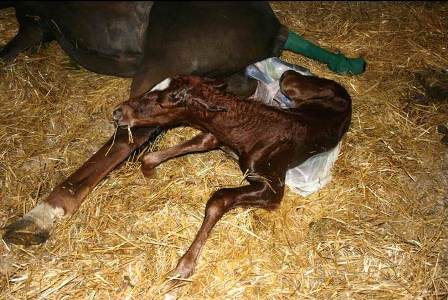 Post-partum colic is a major issue and scientists are still not completely
sure what occurs in a broodmare’s gastrointestinal (GI) tract that makes
them at a greater risk for colic after giving birth. There have been recent
studies characterizing the mare’s gut microbiome during and after pregnancy
as well as immediately before an episode of colic in order to get a better
idea of any changes occurring in their GI tract. Understanding changes in
their microbiome may give us clues on how to better manage broodmares after
parturition.
Post-partum colic is a major issue and scientists are still not completely
sure what occurs in a broodmare’s gastrointestinal (GI) tract that makes
them at a greater risk for colic after giving birth. There have been recent
studies characterizing the mare’s gut microbiome during and after pregnancy
as well as immediately before an episode of colic in order to get a better
idea of any changes occurring in their GI tract. Understanding changes in
their microbiome may give us clues on how to better manage broodmares after
parturition.
Intrafollicular Oocyte Transfer in the Mare
December 10, 2019
Posted by
Dr. Elena Martinez de Andino in
Mare Management
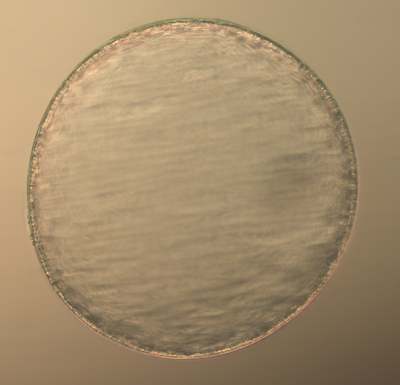 In the equine breeding industry, many different assisted reproduction techniques (ARTs) are widely used to aid the management of equine reproduction. ARTs provide options to owners looking to obtain embryos from genetically valuable mares and/or stallions for whom conventional breeding management strategies are insufficient. This article provides a concise summary of several common ARTs, as well as information regarding innovative techniques just entering clinical use.
In the equine breeding industry, many different assisted reproduction techniques (ARTs) are widely used to aid the management of equine reproduction. ARTs provide options to owners looking to obtain embryos from genetically valuable mares and/or stallions for whom conventional breeding management strategies are insufficient. This article provides a concise summary of several common ARTs, as well as information regarding innovative techniques just entering clinical use.
A brief overview of the equine oviduct: its unique features, signs of pathology and current treatments
November 15, 2019
Posted by
Dr. Maria Schnobrich in
Mare Management
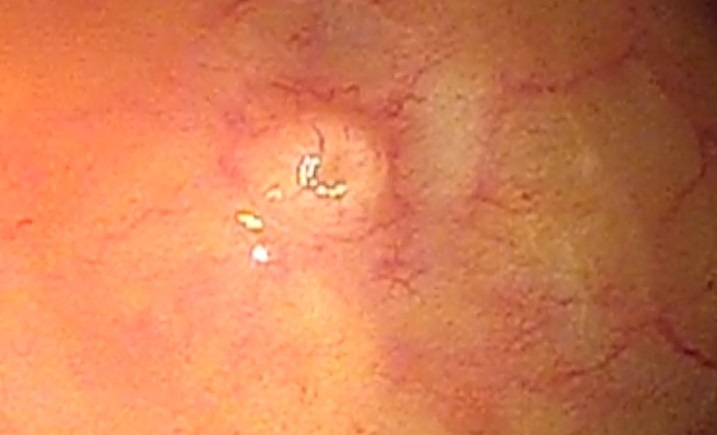 When considering common causes of infertility in the mare, the oviduct is one of the last places an equine reproductive specialist looks. Uterine infections, poor conformation and stallion subfertility are much more likely causes for a mare’s failure to produce a pregnancy. That being said, there are rare cases where oviduct pathology is suspected, and in the past few years there have been advances for oviductal treatment that are cost effective, safe and have restored fertility in some patients. This summary will highlight some unique features of the mare oviduct, discuss when to suspect oviductal pathology or dysfunction, and review some of the current treatments available.
When considering common causes of infertility in the mare, the oviduct is one of the last places an equine reproductive specialist looks. Uterine infections, poor conformation and stallion subfertility are much more likely causes for a mare’s failure to produce a pregnancy. That being said, there are rare cases where oviduct pathology is suspected, and in the past few years there have been advances for oviductal treatment that are cost effective, safe and have restored fertility in some patients. This summary will highlight some unique features of the mare oviduct, discuss when to suspect oviductal pathology or dysfunction, and review some of the current treatments available.
High Prevalence of Latent Endometritis in Problem Mares: Effect of Activation and Treatment on Fertility
March 05, 2019
Posted by
MR Petersen and AM Bojesen in
Mare Management
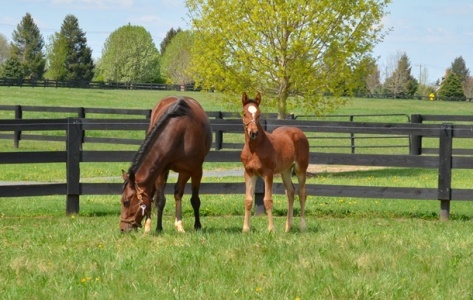 Beta-hemolytic Streptococcus equi subsp. zooepidemicus
(BHS) is the most frequently isolated pathogen in the uterus of mares. However, in a large fraction (>50%) of subfertile mares there is no
obvious reason identified. We recently demonstrated that BHS have the
ability to reside deep in endometrium and may also gain intracellular
access. The ability to escape and hide from the immune system allows BHS to
cause long lasting, hardly detectable infections. In addition to this, we
have shown that BHS are able to enter a dormant state where the bacteria
can slow down their metabolism. Most antibiotics inhibit bacterial growth
by disrupting the microbial metabolism which makes the dormant bacteria
highly tolerant to antibiotics.
Beta-hemolytic Streptococcus equi subsp. zooepidemicus
(BHS) is the most frequently isolated pathogen in the uterus of mares. However, in a large fraction (>50%) of subfertile mares there is no
obvious reason identified. We recently demonstrated that BHS have the
ability to reside deep in endometrium and may also gain intracellular
access. The ability to escape and hide from the immune system allows BHS to
cause long lasting, hardly detectable infections. In addition to this, we
have shown that BHS are able to enter a dormant state where the bacteria
can slow down their metabolism. Most antibiotics inhibit bacterial growth
by disrupting the microbial metabolism which makes the dormant bacteria
highly tolerant to antibiotics.
Unexplained Subfertility in Broodmares
February 05, 2019
Posted by
Dr. Stephanie Walbornn in
Mare Management
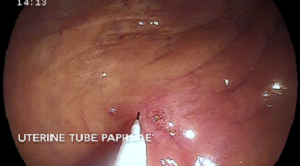 Breeding season is just around the corner and most breeders dread the frustration of subfertility in certain broodmares. A thorough breeding history is key to diagnosing the cause of subfertility. Questions that address previous breeding management, stallion selection, and general wellness are important when performing a breeding soundness evaluation. Diagnostics such as trans-rectal palpation and ultrasound examination of the reproductive tract, vaginal speculum examination, digital cervical palpation, endometrial cytology and culture, endometrial biopsy, and hysteroscopic examination are useful in determining the cause of subfertility. Typically, a cause of subfertility can be determined utilizing the diagnostics mentioned above, but there may be some cases in which diagnostic test results are negative and yet a mare is still subfertile. So what’s next?
Breeding season is just around the corner and most breeders dread the frustration of subfertility in certain broodmares. A thorough breeding history is key to diagnosing the cause of subfertility. Questions that address previous breeding management, stallion selection, and general wellness are important when performing a breeding soundness evaluation. Diagnostics such as trans-rectal palpation and ultrasound examination of the reproductive tract, vaginal speculum examination, digital cervical palpation, endometrial cytology and culture, endometrial biopsy, and hysteroscopic examination are useful in determining the cause of subfertility. Typically, a cause of subfertility can be determined utilizing the diagnostics mentioned above, but there may be some cases in which diagnostic test results are negative and yet a mare is still subfertile. So what’s next?
Progesterone Therapy for Pregnant Mares - Part 2: The Most Common Questions
January 15, 2019
Posted by
Dr. Dave Scofield in
Mare Management
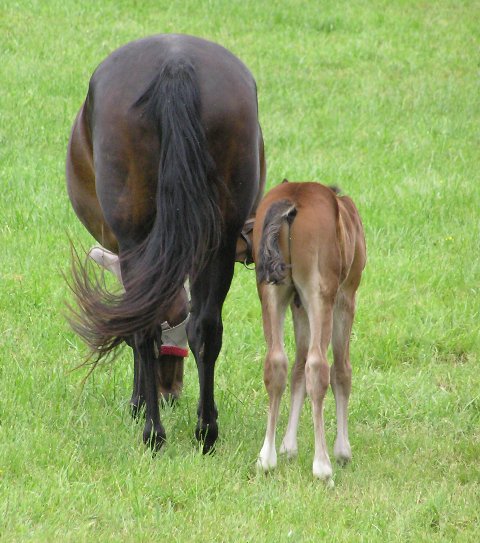 Thank you to Dr. Pat McCue from the Equine Reproduction Laboratory for last
month’s article, Progesterone Therapy for Pregnant Mares – Part 1, in which
he reviewed the formulations and use of progesterone therapy in mares. Dr.
McCue did a yeoman’s task in outlining the formulations and principles of
therapy available to veterinarians for the suppression of estrus, pregnancy
support, and treating cases of suspected or diagnosed placentitis. However,
the maintenance of pregnancy is by far the most common area in which we
receive questions about supplementing mares with exogenous (therapeutic)
forms of progesterone.
Thank you to Dr. Pat McCue from the Equine Reproduction Laboratory for last
month’s article, Progesterone Therapy for Pregnant Mares – Part 1, in which
he reviewed the formulations and use of progesterone therapy in mares. Dr.
McCue did a yeoman’s task in outlining the formulations and principles of
therapy available to veterinarians for the suppression of estrus, pregnancy
support, and treating cases of suspected or diagnosed placentitis. However,
the maintenance of pregnancy is by far the most common area in which we
receive questions about supplementing mares with exogenous (therapeutic)
forms of progesterone.
Progesterone Therapy for Pregnant Mares - Part 1
December 06, 2018
Posted by
Dr. Dave Scofield in
Mare Management
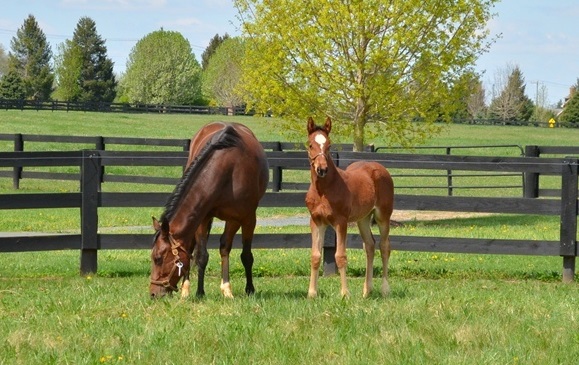 By far, the most discussed topic is supplementation of progesterone to pregnant mares to help them maintain a pregnancy. Many times, the questions stem from the necessity of such therapy, duration, and efficacy of supplementation. Sometimes, even with the best therapy, we fail to reach a good outcome, but the following discussion about the forms of supplementing progesterone is well worth a quick read for any breeder.
By far, the most discussed topic is supplementation of progesterone to pregnant mares to help them maintain a pregnancy. Many times, the questions stem from the necessity of such therapy, duration, and efficacy of supplementation. Sometimes, even with the best therapy, we fail to reach a good outcome, but the following discussion about the forms of supplementing progesterone is well worth a quick read for any breeder.
Measuring Hormone Levels in Mares
March 02, 2018
Posted by
Dr. Ed Squires in
Mare Management
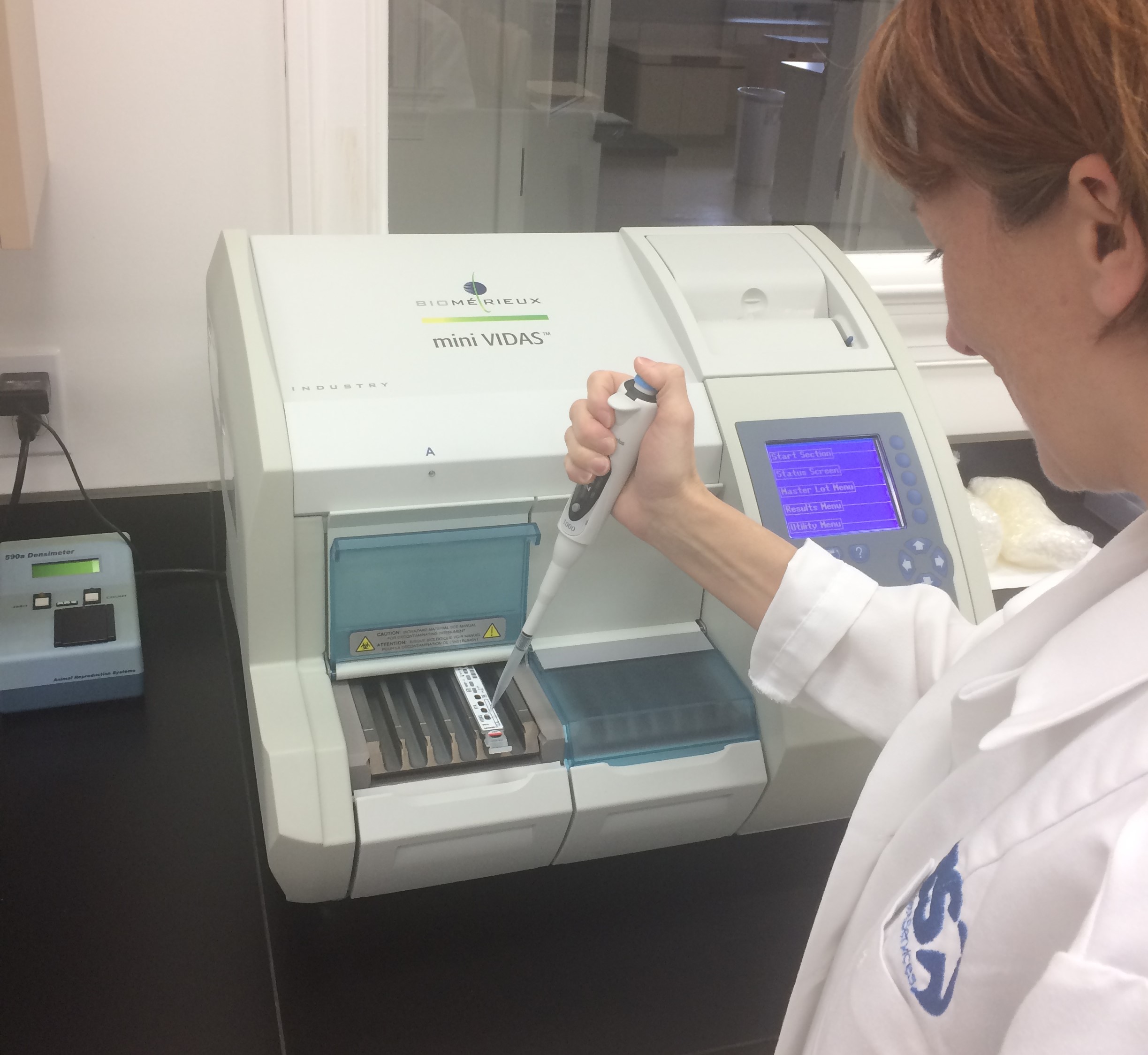 Endocrine diagnostics certainly have a place in the routine management of mares and stallions as well as in diagnosis of problems and diseases. However, there are likely more applications for measuring hormones in mares than stallions. Dr. Ed Squires will discuss the hormones tested in mares in this article and will then cover the testing of stallion hormones in a subsequent article.
Endocrine diagnostics certainly have a place in the routine management of mares and stallions as well as in diagnosis of problems and diseases. However, there are likely more applications for measuring hormones in mares than stallions. Dr. Ed Squires will discuss the hormones tested in mares in this article and will then cover the testing of stallion hormones in a subsequent article.
Management of Late Gestation Pregnancy Loss in the Mare
December 11, 2017
Posted by
Dr. Ute Pansegrau in
Mare Management
Breeding season in the northern hemisphere is over and hopefully all mares are in foal. Waiting for the arrival of the foals next year has begun. But what if something goes wrong? Abortion after day 45 of gestation occurs up to 3 to 15% in different horse populations. Infectious and non-infectious causes can be involved. It is important, that as long as the etiology of the pregnancy loss is undetermined, every abortion should be assumed as infectious until proven otherwise. How do you best handle the situation when a mare aborts and how do you prevent further damage to the mare or her fellow broodmares?
Trends in Equine Assisted Reproduction
October 03, 2017
Posted by
Dr. Ed Squires in
Mare Management
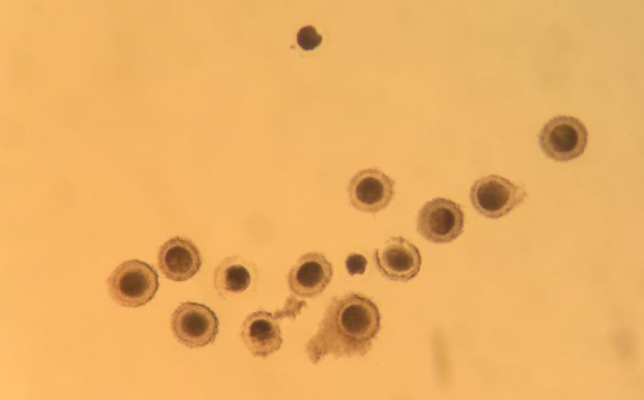 It has been almost 20 years since I started an assisted reproduction program at Colorado state University. The purpose of that program was to develop techniques to preserve equine genetics. It is beyond the scope of this article to discuss all the goals of that program but I would like to focus on production of foals from old mares and stallions via in vitro technology (aka test tube horse).
It has been almost 20 years since I started an assisted reproduction program at Colorado state University. The purpose of that program was to develop techniques to preserve equine genetics. It is beyond the scope of this article to discuss all the goals of that program but I would like to focus on production of foals from old mares and stallions via in vitro technology (aka test tube horse).
Is the Volume of the Inseminate Important for Fertility?
March 05, 2017
Posted by
Dr. Ed Squires in
Mare Management
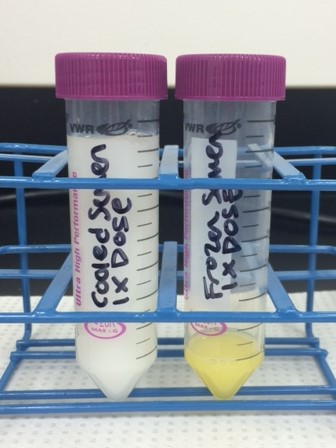 A common question asked by many breeders is whether the volume of semen deposited into the mare affects fertility. When a mare and a stallion mate naturally the entire ejaculate is deposited into the mare. This volume is usually 50 ml or more and includes several billion sperm. However, when breeding mares using artificial insemination, good fertility can be achieved with as little as 1/2 ml of semen. I have been telling breeders for years that the volume of the ejaculate is not important as long as the stallion is producing good sperm numbers. For example, a stallion can produce 8 billion sperm with 80 ml of semen at a concentration of 100 million sperm/ml or 20 ml of semen at a concentration of 400 million sperm/ml. Volume of the ejaculate and concentration are inversely related (i.e. if volume goes up then concentration goes down).
A common question asked by many breeders is whether the volume of semen deposited into the mare affects fertility. When a mare and a stallion mate naturally the entire ejaculate is deposited into the mare. This volume is usually 50 ml or more and includes several billion sperm. However, when breeding mares using artificial insemination, good fertility can be achieved with as little as 1/2 ml of semen. I have been telling breeders for years that the volume of the ejaculate is not important as long as the stallion is producing good sperm numbers. For example, a stallion can produce 8 billion sperm with 80 ml of semen at a concentration of 100 million sperm/ml or 20 ml of semen at a concentration of 400 million sperm/ml. Volume of the ejaculate and concentration are inversely related (i.e. if volume goes up then concentration goes down).
Oxytocin Use in the Mare
December 28, 2016
Posted by
Dr. Dave Scofield in
Mare Management
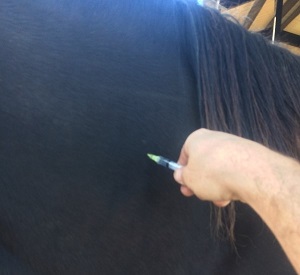 Oxytocin is one of the most utilized hormones in broodmare practice. With so many possible clinical applications, a review of the use of oxytocin in the mare highlights the benefits of oxytocin, as well as necessary precautions with its use. Oxytocin is a nine-amino acid neuropeptide that is produced in the hypothalamus and released by hypothalamic neurons that terminate in the posterior pituitary. It is released in a natural pulsatile manner and exerts its effects by coupling with oxytocin receptors on various tissues such as the endometrium, myometrium, heart, kidney, pancreas, and fat tissue. There are also local effects of oxytocin and receptor binding, notably in the utero-placental tissues that help to increase the effect and intensity of pituitary derived oxytocin pulses. Clinically, oxytocin is available as a sterile injection, 20 IU (international units) per milliter. It can be administered intravenously or intramuscularly.
Oxytocin is one of the most utilized hormones in broodmare practice. With so many possible clinical applications, a review of the use of oxytocin in the mare highlights the benefits of oxytocin, as well as necessary precautions with its use. Oxytocin is a nine-amino acid neuropeptide that is produced in the hypothalamus and released by hypothalamic neurons that terminate in the posterior pituitary. It is released in a natural pulsatile manner and exerts its effects by coupling with oxytocin receptors on various tissues such as the endometrium, myometrium, heart, kidney, pancreas, and fat tissue. There are also local effects of oxytocin and receptor binding, notably in the utero-placental tissues that help to increase the effect and intensity of pituitary derived oxytocin pulses. Clinically, oxytocin is available as a sterile injection, 20 IU (international units) per milliter. It can be administered intravenously or intramuscularly.
Ways to Determine Equine Fetal Gender
December 08, 2016
Posted by
Dr. Anna Toenissen in
Mare Management
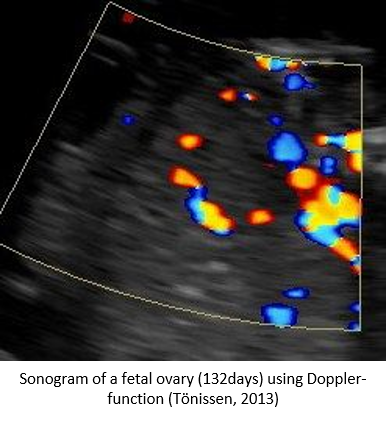 Horse breeders are always interested in the well being of their broodmares as well as the well being of the fetus they are carrying. Advances in reproductive techniques have made it possible to gain insight into how the fetus is progressing as well as the ability to determine its gender. Knowing whether a mare is carrying a colt or a filly can help owners make important decisions concerning their herds and the industry in general. For example, fetal sex determination is used on a regular basis among thoroughbred breeders prior to stock auctions. In this article, we discuss the sorting of equine sperm for sex as well as fetal sex determination via transrectal and transabdominal ultrasound.
Horse breeders are always interested in the well being of their broodmares as well as the well being of the fetus they are carrying. Advances in reproductive techniques have made it possible to gain insight into how the fetus is progressing as well as the ability to determine its gender. Knowing whether a mare is carrying a colt or a filly can help owners make important decisions concerning their herds and the industry in general. For example, fetal sex determination is used on a regular basis among thoroughbred breeders prior to stock auctions. In this article, we discuss the sorting of equine sperm for sex as well as fetal sex determination via transrectal and transabdominal ultrasound.
Suppression of Stallion and Mare Behavior
November 07, 2016
Posted by
Dr. Ed Squires in
Mare Management
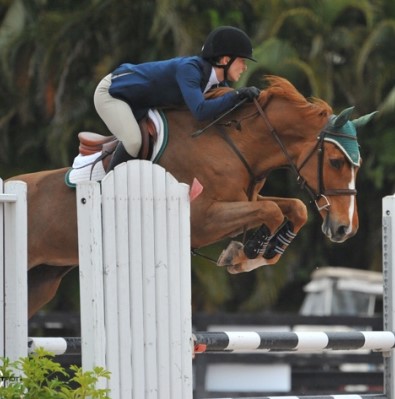 Once young colts and fillies reach the age of puberty their behavior may become an issue in the show ring or on the race track. Castrating a colt which you intend to use for breeding purposes may not be an option and mares are not typically permanently sterilized. Their sexual behavior may also cause problems with housing, trail riding, etc. In this article, Dr. Ed Squires discusses some of the common ways stallion and mare owners suppress the behavior of their horses.
Once young colts and fillies reach the age of puberty their behavior may become an issue in the show ring or on the race track. Castrating a colt which you intend to use for breeding purposes may not be an option and mares are not typically permanently sterilized. Their sexual behavior may also cause problems with housing, trail riding, etc. In this article, Dr. Ed Squires discusses some of the common ways stallion and mare owners suppress the behavior of their horses.
What Can Cause a Mare to Lose Her Pregnancy?
April 01, 2016
Posted by
Karen Wolfsdorf, DVM, DACT in
Mare Management
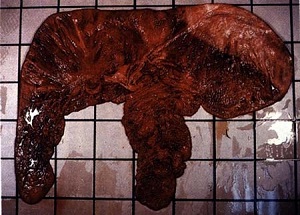 Mares can develop problems during pregnancy or be at high risk of losing the pregnancy for a variety of reasons. These include age (old mares frequently have endometriosis in which the uterus is unable to properly supply the fetus with appropriate blood supply and nutrients), physical conditions (placental and fetal fluid abnormalities; body wall tears; chronic debilitating conditions such as laminitis and Cushing’s disease), and acute disease or injury (placentitis, uterine torsion, surgical colic, colitis, acute laminitis, or fractures). When a mare becomes stressed or debilitated, inflammatory chemicals and prostaglandins increase and induce abnormal uterine contractions and potential pregnancy loss. Reproductive problems that arise during gestation, however, when detected and diagnosed early, can still result in the survival of the mare and usually the foal. The abnormalities most commonly seen during the middle to late stages of pregnancy will be discussed in this article.
Mares can develop problems during pregnancy or be at high risk of losing the pregnancy for a variety of reasons. These include age (old mares frequently have endometriosis in which the uterus is unable to properly supply the fetus with appropriate blood supply and nutrients), physical conditions (placental and fetal fluid abnormalities; body wall tears; chronic debilitating conditions such as laminitis and Cushing’s disease), and acute disease or injury (placentitis, uterine torsion, surgical colic, colitis, acute laminitis, or fractures). When a mare becomes stressed or debilitated, inflammatory chemicals and prostaglandins increase and induce abnormal uterine contractions and potential pregnancy loss. Reproductive problems that arise during gestation, however, when detected and diagnosed early, can still result in the survival of the mare and usually the foal. The abnormalities most commonly seen during the middle to late stages of pregnancy will be discussed in this article.
The History of the Frozen Semen Two-Dose Timed Insemination Protocol
January 07, 2016
Posted by
SBS in
Mare Management
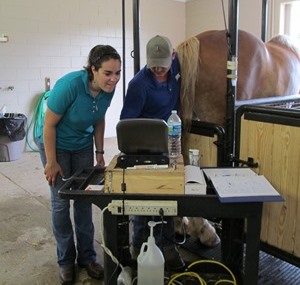 The use of the two-dose timed insemination protocol allows veterinarians the flexibility to examine mares once daily during normal hours without compromising fertility but while reducing management costs for the mare owner. This is the main reason why this protocol was developed by Dr. Sandro Barbacini of SBS Italia. Prior to developing this protocol most veterinarians would ultrasound mares every three to four hours in order to inseminate them with frozen semen as close to ovulation as possible. However, such a protocol is not only exhausting for the veterinarian but can also be a financial burden for the mare owner. In this article we will review the history of the two-dose timed insemination protocol, why it was developed, and discuss how it’s use can help with your breeding program.
The use of the two-dose timed insemination protocol allows veterinarians the flexibility to examine mares once daily during normal hours without compromising fertility but while reducing management costs for the mare owner. This is the main reason why this protocol was developed by Dr. Sandro Barbacini of SBS Italia. Prior to developing this protocol most veterinarians would ultrasound mares every three to four hours in order to inseminate them with frozen semen as close to ovulation as possible. However, such a protocol is not only exhausting for the veterinarian but can also be a financial burden for the mare owner. In this article we will review the history of the two-dose timed insemination protocol, why it was developed, and discuss how it’s use can help with your breeding program.
How to Prepare the Older Mare for Breeding Season
October 30, 2015
Posted by
Dr. Dave Scofield in
Mare Management
 Older mares have a knack for being the sweetest and gentlest mares on the farm. We see them year after year, either carrying their own foals or returning to donate embryos if their reproductive status requires. Oftentimes, these mares are considered “special” patients, requiring a unique combination of diet, exercise, and metabolic support to maintain their physical and reproductive health. We often see older performance mares that are being bred for the first time following a long and successful show career. Reproductive problems such as cervical adhesions and uterine infection can be common in older mares which affect their ability to carry a foal or donate an embryo.
Older mares have a knack for being the sweetest and gentlest mares on the farm. We see them year after year, either carrying their own foals or returning to donate embryos if their reproductive status requires. Oftentimes, these mares are considered “special” patients, requiring a unique combination of diet, exercise, and metabolic support to maintain their physical and reproductive health. We often see older performance mares that are being bred for the first time following a long and successful show career. Reproductive problems such as cervical adhesions and uterine infection can be common in older mares which affect their ability to carry a foal or donate an embryo.
Riding the Pregnant Mare
October 30, 2015
Posted by
SBS in
Mare Management
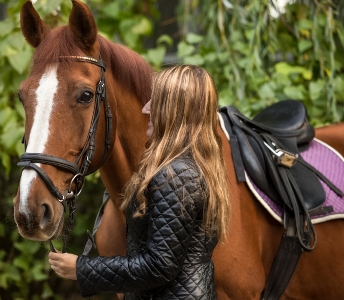 Knowing when to stop riding your pregnant broodmare can be a debatable topic. This article will review recommended time points yet, like an individual person, each broodmare has independent feelings and each pregnancy can be different for a particular broodmare. There are noticeable signs your broodmare may be showing you she is uncomfortable or physically unable to do certain movements you ask of her when riding. It is always recommended that you consult your veterinarian when deciding the best plan of action regarding riding your broodmare and how strenuous the activity should be.
Knowing when to stop riding your pregnant broodmare can be a debatable topic. This article will review recommended time points yet, like an individual person, each broodmare has independent feelings and each pregnancy can be different for a particular broodmare. There are noticeable signs your broodmare may be showing you she is uncomfortable or physically unable to do certain movements you ask of her when riding. It is always recommended that you consult your veterinarian when deciding the best plan of action regarding riding your broodmare and how strenuous the activity should be.
Balancing the Show and Breeding Careers of an Embryo Transfer Donor Mare
May 30, 2015
Posted by
SBS in
Mare Management
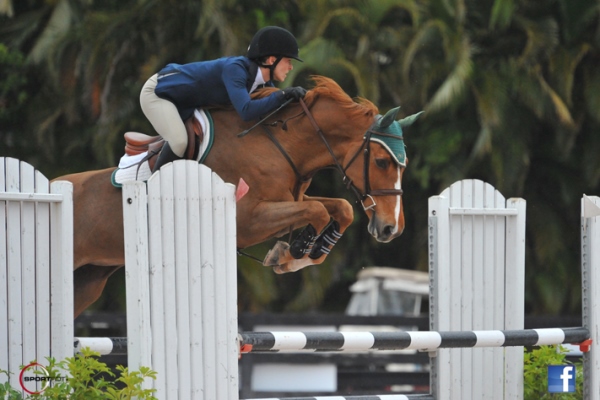 When one thinks of a broodmare they may think she is retired from the show ring and living out her days, pregnant in a pasture. However, with the implementation of embryo transfer (ET) in the horse breeding industry it is possible for a mare to produce several offspring in a given breeding season while continuing in competition. We recently published an article about Balancing a Stallion’s Life in the Breeding Shed with Competing in the Show Ring. Now it’s time to consider what goes into balancing the show and breeding career of an ET donor mare. In this article we will discuss reasons an owner may choose to breed their show mare and what to consider when determining if this is a path you wish to travel.
When one thinks of a broodmare they may think she is retired from the show ring and living out her days, pregnant in a pasture. However, with the implementation of embryo transfer (ET) in the horse breeding industry it is possible for a mare to produce several offspring in a given breeding season while continuing in competition. We recently published an article about Balancing a Stallion’s Life in the Breeding Shed with Competing in the Show Ring. Now it’s time to consider what goes into balancing the show and breeding career of an ET donor mare. In this article we will discuss reasons an owner may choose to breed their show mare and what to consider when determining if this is a path you wish to travel.
Is Deep Horn Insemination Beneficial When Breeding With Equine Frozen Semen?
May 02, 2015
Posted by
Dr. Ed Squires in
Mare Management
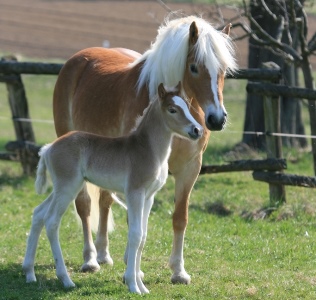 There have been many changes in how we produce foals from our broodmares in the past few decades: cooled semen, frozen semen, embryo transfer, frozen embryos, etc. One procedure that has gained popularity is deep horn insemination. This refers to placing the semen deep in the uterine horn, close to the opening of the oviduct (uterotubal junction, UTJ) on the side of ovulation instead of depositing it in the uterine body. This is typically done using a flexible pipette that can be guided to the tip of the horn with the other hand in the rectum. The end of the pipette and the tip of the uterine horn can both be felt using this method.
There have been many changes in how we produce foals from our broodmares in the past few decades: cooled semen, frozen semen, embryo transfer, frozen embryos, etc. One procedure that has gained popularity is deep horn insemination. This refers to placing the semen deep in the uterine horn, close to the opening of the oviduct (uterotubal junction, UTJ) on the side of ovulation instead of depositing it in the uterine body. This is typically done using a flexible pipette that can be guided to the tip of the horn with the other hand in the rectum. The end of the pipette and the tip of the uterine horn can both be felt using this method.
Biofilms in Mare Reproduction
February 27, 2015
Posted by
Dr. Ryan Ferris in
Mare Management
A biofilm has been proposed to have a significant role in chronic infections in the horse. It has been suggested for over a decade that chronic uterine infections resistant to antimicrobials may be due to biofilm production. The involvement of a biofilm in cases of bacterial endometritis has not been clearly elucidated, but many reproductive specialists suspect a biofilm plays a significant role in infectious endometritis. In this article Dr. Ryan Ferris, a board certified theriogenologist from Colorado State University, explains the lifestyles of bacteria, how a biofilm is formed, how they protect bacteria and their implications on equine reproduction.
Ovum Pickup in the Mare
January 03, 2015
Posted by
Dr. Gabe Young in
Mare Management
Breeding horses has come a long ways in the last 50 years. Veterinarians have been able to overcome many of the obstacles presented when breeding horses with advancements in artificial insemination and embryo transfer. However, there are still times when infertility of either the mare, stallion or both prevent getting foals on the ground. The most recent advances in assisted reproductive technologies, Ovum Pickup and Intra-Cytoplasmic Sperm Injection (ICSI), have allowed us at Weatherford Equine Breeding Center (WEBC) to take the next step in overcoming these obstacles with some promising results.
Effect of Number and Timing of Equine Frozen Semen Inseminations on Fertility
December 03, 2014
Posted by
Dr. Ed Squires in
Mare Management
Further expansion in the use of frozen semen is dependent upon developing simplified strategies for insemination. SBS has developed a timed insemination protocol where mares are only examined once per day during estrus and inseminated at 24 and 40 hr after hCG or 30 and 40 hr after GnRH. This approach allows frozen semen mares to be managed similar to those bred with cooled shipped semen. A couple of arguments against this approach with frozen semen is that it takes too much semen when mares are bred twice in one cycle and that if the mare is inseminated more than once per cycle the fertility will be lowered because of post-breeding induced endometritis. However, in a new retrospective study across 1871 mare cycles bred by SBS affiliate labs, we report additional support for the use of two inseminations per breeding cycle.
New Alternative to Putting Your Mare Under Lights
October 31, 2014
Posted by
Dr. Jerry Longworth in
Mare Management
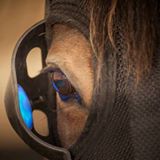 It has long been a goal for equine breeders to produce foals born as early in the year as possible. Foals born early in the year have a distinct economic advantage for breeders. However, Mother Nature, has a different plan.
It has long been a goal for equine breeders to produce foals born as early in the year as possible. Foals born early in the year have a distinct economic advantage for breeders. However, Mother Nature, has a different plan.
Colic in the Broodmare
September 08, 2014
Posted by
Dr. Dave Scofield in
Mare Management
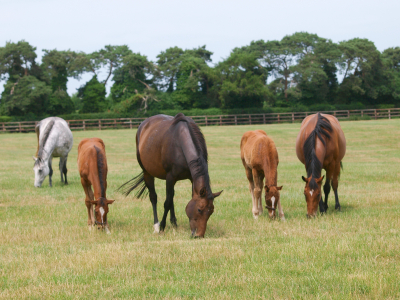 Colic is usually a word that brings to mind fussy sick newborn children, sleepless nights, and sleep-deprived parents, unless you are a horse owner. Many horse owners live in fear of finding their horses in an episode of colic. Fortunately, many bouts of gastro-intestinal pain are mild, easily treated, or easily managed on the farm or with a visit from your veterinary professional. More serious episodes could be much more in depth, require extended medical therapy and possibly abdominal surgery. No episode of colic should be taken lightly and often times, intervention by your veterinary team can help prevent escalation of the pain and disease in the horse. In cases of serious colic, swift intervention can positively affect the outcome of prolonged hospitalization or surgical repair.
Colic is usually a word that brings to mind fussy sick newborn children, sleepless nights, and sleep-deprived parents, unless you are a horse owner. Many horse owners live in fear of finding their horses in an episode of colic. Fortunately, many bouts of gastro-intestinal pain are mild, easily treated, or easily managed on the farm or with a visit from your veterinary professional. More serious episodes could be much more in depth, require extended medical therapy and possibly abdominal surgery. No episode of colic should be taken lightly and often times, intervention by your veterinary team can help prevent escalation of the pain and disease in the horse. In cases of serious colic, swift intervention can positively affect the outcome of prolonged hospitalization or surgical repair.
Retained Placenta in the Mare
June 02, 2014
Posted by
Dr. Igor Canisso in
Mare Management
Retained placenta (also known as retained fetal membranes) is the most common post-partum complication in mares. Typically, expulsion of the placenta occurs shortly after birth and it is considered retained if it is not expelled within 3 hours post-partum. The prevalence of retained placenta varies from 2 to 10% of foalings and can be as high as 30 -54% of uneventful births in Friesian mares. Retention of the placenta in mares should not be overlooked.
Appropriate diagnosis and treatment should be quickly applied to prevent
secondary, life threatening, complications.
Placentitis in the Mare - Causes, Diagnosis, and Treatment
April 01, 2014
Posted by
Dr. Karen Wolfsdorf in
Mare Management
Placentitis, an inflammation of the placenta usually caused by an infectious agent, has emerged as a leading cause of reproductive loss in the equine breeding industry. This has a large economic and emotional impact when the pregnancy progresses until close to term but unfortunately ends in abortion or the birth of a small ill-thrifty foal. The placenta is composed of the amnion, which surrounds the fetus, and the chorio-allantois that attaches to the endometrium of the mare. These structures protect the fetus and provide gas and nutrient exchange allowing the foal to grow. When placentitis occurs it usually affects the chorioallantois compromising the foal because there is a loss of attachment of the placenta to the endometrium or the presence of infection and inflammation.
What is Short Cycling a Mare?
March 05, 2014
Posted by
Dr. Dave Scofield in
Mare Management
It seems daily that I am asked by clients to bring a mare into heat at a desired time to facilitate breeding, show schedules, stallion availability, synchronization with other mares, maximize early season breeding dates, or line up recipient mares with donor mares. For such a common request, and in fact, a common procedure, there are certain cases when knowing the nuisances of manipulating the length of diestrus in the mare can make or break the overall success of a reproductive cycle. In this blog article we review the process of short cycling mares.
Parturition in the Mare
March 19, 2013
Posted by
Dr. Dave Scofield in
Mare Management
In our newsletter last month, we talked about getting organized and ready for foaling out your mare (click here for this news article). Being prepared for the foaling process is of paramount importance, in order to have an enjoyable and successful outcome for the mare, foal, breeders, owners, and attendants. As you are preparing your barn for the foaling, don’t forget that the mare has a chorus of events taking place internally to prepare her body for parturition, transition to lactation, and uterine involution. Whether these events are noticeable or not, they are a necessity for the proper progression of labor and delivery. In our blog article this month Dr. Scofield reviews the stages of parturition and summarizes the hormonal events that are occurring with your mare during this incredible physiological process.
Progesterone and Estrogen Therapy (P&E)
February 19, 2013
Posted by
Dr. Dave Scofield in
Mare Management
Managing the equine estrous cycle is a common procedure performed by many broodmare managers and veterinarians. Copious research has elucidated many aspects of the equine estrous cycle and allowed veterinarians the tools to manage a mare’s cycle to provide the optimal breeding times, effectively use artificial insemination, induce ovulation, synchronize mares, induce superovulation, advance the onset of the breeding season, terminate pregnancy, as well as a manage a host of other reproductive conditions and diseases. In this article we take a look at the use of progesterone and estradiol (P&E) as therapy in the mare.
How to Find a Good Equine Reproduction Veterinarian
January 23, 2013
Posted by
Dr. Dave Scofield in
Mare Management
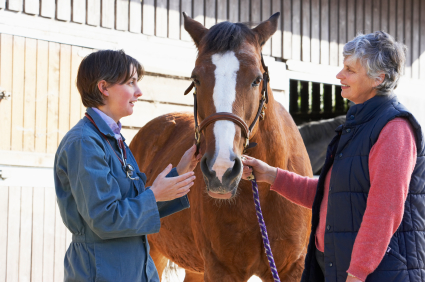 Owning an animal, be it a household pet, horses, or livestock can be wonderfully rewarding. There are times, however, when the responsibility of animal ownership requires the consultation of a veterinarian to ensure the health and well being of your animals or livestock. Most of these appointments will be for routine care, whereas other visits may require specialized services, like lameness diagnosis, surgery or reproductive management. Many horse owners use different veterinarians or vet clinics depending upon the services they require. However, those in more isolated or rural areas may be limited to a general practice veterinarian who routinely works with all species, being neither an equine or reproduction specialist. A breeder can still be equally successful in both situations, so long as they are prepared and have done their research to find the best veterinarian available to suit their needs.
Owning an animal, be it a household pet, horses, or livestock can be wonderfully rewarding. There are times, however, when the responsibility of animal ownership requires the consultation of a veterinarian to ensure the health and well being of your animals or livestock. Most of these appointments will be for routine care, whereas other visits may require specialized services, like lameness diagnosis, surgery or reproductive management. Many horse owners use different veterinarians or vet clinics depending upon the services they require. However, those in more isolated or rural areas may be limited to a general practice veterinarian who routinely works with all species, being neither an equine or reproduction specialist. A breeder can still be equally successful in both situations, so long as they are prepared and have done their research to find the best veterinarian available to suit their needs.
Hastening the Onset of the Breeding Season
November 20, 2012
Posted by
Dr. Dave Scofield in
Mare Management
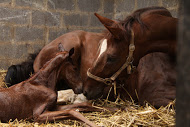 The horse is a seasonal breeder meaning that natural mating occurs during certain times of the year to ensure that the timing of birth is optimal for survival with regard to ambient temperature, food and water availability, and even changes in the predation behaviors of other species. Seasonal breeders are controlled by the length of daylight, i.e. the photoperiod, and can be divided into long day breeders, e.g. the horse, that start cycling when the days get longer (spring) and short day breeders, e.g. deer and some breeds of small ruminants, that start cycling when the days get shorter (fall). The length of photoperiod can be manipulated in order to hasten the onset of the breeding season. This is a popular management technique used in many breeds, so foals can be born as close to the standardized January 1st birth date as possible. It is also common with show or halter horses, with the goal being to maximize maturity for age determined competition.
The horse is a seasonal breeder meaning that natural mating occurs during certain times of the year to ensure that the timing of birth is optimal for survival with regard to ambient temperature, food and water availability, and even changes in the predation behaviors of other species. Seasonal breeders are controlled by the length of daylight, i.e. the photoperiod, and can be divided into long day breeders, e.g. the horse, that start cycling when the days get longer (spring) and short day breeders, e.g. deer and some breeds of small ruminants, that start cycling when the days get shorter (fall). The length of photoperiod can be manipulated in order to hasten the onset of the breeding season. This is a popular management technique used in many breeds, so foals can be born as close to the standardized January 1st birth date as possible. It is also common with show or halter horses, with the goal being to maximize maturity for age determined competition.
Care and Vaccination of the Pregnant Mare
September 18, 2012
Posted by
SBS in
Mare Management
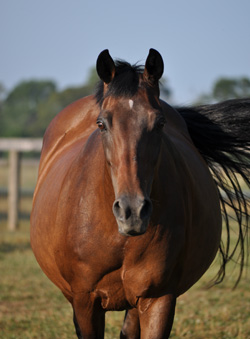 Now that your mare is safely checked in foal, the next step in the journey begins. It is time to plan ahead for the care and management of your pregnant mare and for welcoming the arrival of your foal. A major first step is, where will your mare foal out? If she is to foal out at home it is assumed you have a suitable foaling stall, a pasture with shelter and safe fencing to house the mare and her foal. Research and start to compile your foaling kit, emergency plans and contacts, secure a source of colostrum and research options for nurse mares. Of course, we all hope for a normal, successful delivery, but we have to be prepared for worst case scenarios. If the unexpected happens at such an emotional time, having a plan in place will alleviate stress and save time when tough decisions must be made. If your mare will foal out at another facility, plan on moving her 20-30 days prior to foaling so she can build up immunity to her new local environment.
Now that your mare is safely checked in foal, the next step in the journey begins. It is time to plan ahead for the care and management of your pregnant mare and for welcoming the arrival of your foal. A major first step is, where will your mare foal out? If she is to foal out at home it is assumed you have a suitable foaling stall, a pasture with shelter and safe fencing to house the mare and her foal. Research and start to compile your foaling kit, emergency plans and contacts, secure a source of colostrum and research options for nurse mares. Of course, we all hope for a normal, successful delivery, but we have to be prepared for worst case scenarios. If the unexpected happens at such an emotional time, having a plan in place will alleviate stress and save time when tough decisions must be made. If your mare will foal out at another facility, plan on moving her 20-30 days prior to foaling so she can build up immunity to her new local environment.
My Mare is Not Pregnant - What Now?
September 18, 2012
Posted by
Dr. Holly Mason in
Mare Management
If you bred your mare last year and were unable to get her in foal, you are not alone. According to The Jockey Club, 44,184 mares were bred in North America in 2010 of these only 23,558 live foals were registered in 2011. A stallion with good semen quality, a mare with a healthy reproductive tract and properly timed inseminations are three critical elements that must align to maximize your chance of success. If you are looking to improve your odds for the 2013 breeding season, Dr. Holly Mason from Unionville Equine Associates outlines some things you might consider doing now to prepare for the upcoming season.
Mare Owners - Minimize Stress and Promote Success by being Prepared for Breeding Season
May 22, 2012
Posted by
SBS in
Mare Management
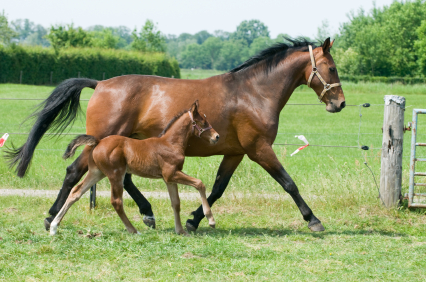 Breeding your mare is a big decision and the prospect can seem quite overwhelming - there is so much to research, organize and plan for as well as many different people to coordinate with. To make this process as stress free as possible, for everyone involved, it pays to be organized. The planning process will be a lot more enjoyable and exciting when you have everything lined up and are not surprised or caught off guard by any unexpected fees, decisions or situations. In this article, we have some suggestions for how you can be more organized for breeding season by considering what needs to be done before the season begins, when it's time to breed, before your mare foals, and once your new foal hits the ground.
Breeding your mare is a big decision and the prospect can seem quite overwhelming - there is so much to research, organize and plan for as well as many different people to coordinate with. To make this process as stress free as possible, for everyone involved, it pays to be organized. The planning process will be a lot more enjoyable and exciting when you have everything lined up and are not surprised or caught off guard by any unexpected fees, decisions or situations. In this article, we have some suggestions for how you can be more organized for breeding season by considering what needs to be done before the season begins, when it's time to breed, before your mare foals, and once your new foal hits the ground.
Breeding Mares on Foal Heat
April 20, 2012
Posted by
Dr. Margo Macpherson in
Mare Management
Breeding mares on their foal heat is a strategy used to maximize reproductive efficiency. Since income is generated from selling offspring, yearly foal production is critical to offset maintenance and breeding expenses incurred by the mare owner. With an average gestational length of 333 to 345 days, mares must become pregnant within one month post partum to continue producing foals each year. Mating mares on the first postpartum estrus is one method used to improve the chance of maintaining yearly foal production. Reviewing this topic for us is guest writer, Dr. Margo Macpherson with an excerpt from the chapter Breeding Mares on Foal Heat co-authored by Dr. Margo Macpherson and Dr. Terry Blanchard in the 2nd Edition of Equine Reproduction.
Preparing Your Mare for Breeding
March 21, 2012
Posted by
Dr. Karen Wolfsdorf in
Mare Management
There are many factors to consider before you breed your mare. This Q&A with reproduction specialist, Dr. Karen Wolfsdorf of Hagyard Equine Medical Institute will help you be prepared.
 Inflammation and/or infection of the endometrium is the leading cause of subfertility in the horse, with persistent breeding-induced endometritis (PBIE) effecting approximately 10-15% of broodmares [1]. The deposition of spermatozoa, seminal plasma, and/or bacteria into the reproductive tract causes an inflammatory response, leading to an activation of the immune system. This involves an activation of signaling molecules (cytokines), recruitment of immune cells (neutrophils), and eventual release of prostaglandin F2 alpha (PGF2a) from the inflamed endometrium, all of which lead to the eventual expulsion of excess fluid and contaminants [2-10].
Inflammation and/or infection of the endometrium is the leading cause of subfertility in the horse, with persistent breeding-induced endometritis (PBIE) effecting approximately 10-15% of broodmares [1]. The deposition of spermatozoa, seminal plasma, and/or bacteria into the reproductive tract causes an inflammatory response, leading to an activation of the immune system. This involves an activation of signaling molecules (cytokines), recruitment of immune cells (neutrophils), and eventual release of prostaglandin F2 alpha (PGF2a) from the inflamed endometrium, all of which lead to the eventual expulsion of excess fluid and contaminants [2-10]. Endocrine diagnostics certainly have a place in the routine management of mares and stallions as well as in diagnosis of problems and diseases. However, there are likely more applications for measuring hormones in mares than stallions. Dr. Ed Squires will discuss the hormones tested in mares in this article and will then cover the testing of stallion hormones in a subsequent article.
Endocrine diagnostics certainly have a place in the routine management of mares and stallions as well as in diagnosis of problems and diseases. However, there are likely more applications for measuring hormones in mares than stallions. Dr. Ed Squires will discuss the hormones tested in mares in this article and will then cover the testing of stallion hormones in a subsequent article.  The establishment and loss of twins, often results in a mare that is barren for a year and the associated economic loss. The incidence of twin births has been documented as occurring in 1-2% of the equine population with twinning accounting for 6-30% of abortions in the mare. When twins are present, gestation proceeds normally until the conceptuses begin to compete for uterine space or placenta. With or without mummification, death of one fetus leads to abortion, usually between 5 and 9 months of gestation. Lactation commonly occurs after one foal dies and causes premature mammary gland development. Surviving foals are usually weaker, more susceptible to infection, and slower to develop than singletons. Fortunately, with the use of ultrasound and an increased understanding of the mechanisms involved in twinning, better approaches to twin reduction have been developed.
The establishment and loss of twins, often results in a mare that is barren for a year and the associated economic loss. The incidence of twin births has been documented as occurring in 1-2% of the equine population with twinning accounting for 6-30% of abortions in the mare. When twins are present, gestation proceeds normally until the conceptuses begin to compete for uterine space or placenta. With or without mummification, death of one fetus leads to abortion, usually between 5 and 9 months of gestation. Lactation commonly occurs after one foal dies and causes premature mammary gland development. Surviving foals are usually weaker, more susceptible to infection, and slower to develop than singletons. Fortunately, with the use of ultrasound and an increased understanding of the mechanisms involved in twinning, better approaches to twin reduction have been developed. Early detection of pregnancy in mares is strongly demanded by owners in order to maximize breeding efficiency and economic investment. The most reliable and earliest available tool for conceptus detection is ultrasonography. Other diagnostics include palpation per rectum and hormonal blood tests (i.e. estrone sulfate in serum or urine; equine chorionic gonadotropin in serum) as these methods are useful when examination by ultrasound (per rectum or transabdominally) is not possible or feasible.
Early detection of pregnancy in mares is strongly demanded by owners in order to maximize breeding efficiency and economic investment. The most reliable and earliest available tool for conceptus detection is ultrasonography. Other diagnostics include palpation per rectum and hormonal blood tests (i.e. estrone sulfate in serum or urine; equine chorionic gonadotropin in serum) as these methods are useful when examination by ultrasound (per rectum or transabdominally) is not possible or feasible. Early demise due to illness or injury can shorten a mare’s reproductive career. Additionally, subfertility can also have a negative impact on a mare’s ability to produce a foal. There have been a multitude of advances in the past 20 years that have allowed for the preservation of genetics in mares. Techniques such as transvaginal ultrasound-guided oocyte aspiration (TVA) and intracytoplasmic sperm injection (ICSI) have allowed us to produce embryos in vitro, circumvent subfertility in mares, and preserve genetics from mares that have died.
Early demise due to illness or injury can shorten a mare’s reproductive career. Additionally, subfertility can also have a negative impact on a mare’s ability to produce a foal. There have been a multitude of advances in the past 20 years that have allowed for the preservation of genetics in mares. Techniques such as transvaginal ultrasound-guided oocyte aspiration (TVA) and intracytoplasmic sperm injection (ICSI) have allowed us to produce embryos in vitro, circumvent subfertility in mares, and preserve genetics from mares that have died. To evaluate a mare's potential for reproductive success or failure, veterinarians often perform a "breeding soundness examination" (BSE). As the breeding season approaches, many owners may opt for a pre-breeding BSE to identify and address any potential reproductive issues prior to breeding. This examination is invaluable for estimating the likelihood of a mare successfully conceiving, carrying a pregnancy to term, and delivering a healthy foal. Pre-breeding examinations are usually performed early in the breeding season when the mare has just begun to cycle or, at the very least, is not in anestrus. Furthermore, the BSE provides veterinarians and owners with important information to determine whether a particular mare should carry a foal herself or whether she might better serve as an embryo or oocyte donor, as well as what breeding strategies are most appropriate for the individual mare.
To evaluate a mare's potential for reproductive success or failure, veterinarians often perform a "breeding soundness examination" (BSE). As the breeding season approaches, many owners may opt for a pre-breeding BSE to identify and address any potential reproductive issues prior to breeding. This examination is invaluable for estimating the likelihood of a mare successfully conceiving, carrying a pregnancy to term, and delivering a healthy foal. Pre-breeding examinations are usually performed early in the breeding season when the mare has just begun to cycle or, at the very least, is not in anestrus. Furthermore, the BSE provides veterinarians and owners with important information to determine whether a particular mare should carry a foal herself or whether she might better serve as an embryo or oocyte donor, as well as what breeding strategies are most appropriate for the individual mare. Post-partum colic is a major issue and scientists are still not completely
sure what occurs in a broodmare’s gastrointestinal (GI) tract that makes
them at a greater risk for colic after giving birth. There have been recent
studies characterizing the mare’s gut microbiome during and after pregnancy
as well as immediately before an episode of colic in order to get a better
idea of any changes occurring in their GI tract. Understanding changes in
their microbiome may give us clues on how to better manage broodmares after
parturition.
Post-partum colic is a major issue and scientists are still not completely
sure what occurs in a broodmare’s gastrointestinal (GI) tract that makes
them at a greater risk for colic after giving birth. There have been recent
studies characterizing the mare’s gut microbiome during and after pregnancy
as well as immediately before an episode of colic in order to get a better
idea of any changes occurring in their GI tract. Understanding changes in
their microbiome may give us clues on how to better manage broodmares after
parturition.
 In the equine breeding industry, many different assisted reproduction techniques (ARTs) are widely used to aid the management of equine reproduction. ARTs provide options to owners looking to obtain embryos from genetically valuable mares and/or stallions for whom conventional breeding management strategies are insufficient. This article provides a concise summary of several common ARTs, as well as information regarding innovative techniques just entering clinical use.
In the equine breeding industry, many different assisted reproduction techniques (ARTs) are widely used to aid the management of equine reproduction. ARTs provide options to owners looking to obtain embryos from genetically valuable mares and/or stallions for whom conventional breeding management strategies are insufficient. This article provides a concise summary of several common ARTs, as well as information regarding innovative techniques just entering clinical use. When considering common causes of infertility in the mare, the oviduct is one of the last places an equine reproductive specialist looks. Uterine infections, poor conformation and stallion subfertility are much more likely causes for a mare’s failure to produce a pregnancy. That being said, there are rare cases where oviduct pathology is suspected, and in the past few years there have been advances for oviductal treatment that are cost effective, safe and have restored fertility in some patients. This summary will highlight some unique features of the mare oviduct, discuss when to suspect oviductal pathology or dysfunction, and review some of the current treatments available.
When considering common causes of infertility in the mare, the oviduct is one of the last places an equine reproductive specialist looks. Uterine infections, poor conformation and stallion subfertility are much more likely causes for a mare’s failure to produce a pregnancy. That being said, there are rare cases where oviduct pathology is suspected, and in the past few years there have been advances for oviductal treatment that are cost effective, safe and have restored fertility in some patients. This summary will highlight some unique features of the mare oviduct, discuss when to suspect oviductal pathology or dysfunction, and review some of the current treatments available. Beta-hemolytic Streptococcus equi subsp. zooepidemicus
(BHS) is the most frequently isolated pathogen in the uterus of mares. However, in a large fraction (>50%) of subfertile mares there is no
obvious reason identified. We recently demonstrated that BHS have the
ability to reside deep in endometrium and may also gain intracellular
access. The ability to escape and hide from the immune system allows BHS to
cause long lasting, hardly detectable infections. In addition to this, we
have shown that BHS are able to enter a dormant state where the bacteria
can slow down their metabolism. Most antibiotics inhibit bacterial growth
by disrupting the microbial metabolism which makes the dormant bacteria
highly tolerant to antibiotics.
Beta-hemolytic Streptococcus equi subsp. zooepidemicus
(BHS) is the most frequently isolated pathogen in the uterus of mares. However, in a large fraction (>50%) of subfertile mares there is no
obvious reason identified. We recently demonstrated that BHS have the
ability to reside deep in endometrium and may also gain intracellular
access. The ability to escape and hide from the immune system allows BHS to
cause long lasting, hardly detectable infections. In addition to this, we
have shown that BHS are able to enter a dormant state where the bacteria
can slow down their metabolism. Most antibiotics inhibit bacterial growth
by disrupting the microbial metabolism which makes the dormant bacteria
highly tolerant to antibiotics.
 Breeding season is just around the corner and most breeders dread the frustration of subfertility in certain broodmares. A thorough breeding history is key to diagnosing the cause of subfertility. Questions that address previous breeding management, stallion selection, and general wellness are important when performing a breeding soundness evaluation. Diagnostics such as trans-rectal palpation and ultrasound examination of the reproductive tract, vaginal speculum examination, digital cervical palpation, endometrial cytology and culture, endometrial biopsy, and hysteroscopic examination are useful in determining the cause of subfertility. Typically, a cause of subfertility can be determined utilizing the diagnostics mentioned above, but there may be some cases in which diagnostic test results are negative and yet a mare is still subfertile. So what’s next?
Breeding season is just around the corner and most breeders dread the frustration of subfertility in certain broodmares. A thorough breeding history is key to diagnosing the cause of subfertility. Questions that address previous breeding management, stallion selection, and general wellness are important when performing a breeding soundness evaluation. Diagnostics such as trans-rectal palpation and ultrasound examination of the reproductive tract, vaginal speculum examination, digital cervical palpation, endometrial cytology and culture, endometrial biopsy, and hysteroscopic examination are useful in determining the cause of subfertility. Typically, a cause of subfertility can be determined utilizing the diagnostics mentioned above, but there may be some cases in which diagnostic test results are negative and yet a mare is still subfertile. So what’s next? By far, the most discussed topic is supplementation of progesterone to pregnant mares to help them maintain a pregnancy. Many times, the questions stem from the necessity of such therapy, duration, and efficacy of supplementation. Sometimes, even with the best therapy, we fail to reach a good outcome, but the following discussion about the forms of supplementing progesterone is well worth a quick read for any breeder.
By far, the most discussed topic is supplementation of progesterone to pregnant mares to help them maintain a pregnancy. Many times, the questions stem from the necessity of such therapy, duration, and efficacy of supplementation. Sometimes, even with the best therapy, we fail to reach a good outcome, but the following discussion about the forms of supplementing progesterone is well worth a quick read for any breeder. It has been almost 20 years since I started an assisted reproduction program at Colorado state University. The purpose of that program was to develop techniques to preserve equine genetics. It is beyond the scope of this article to discuss all the goals of that program but I would like to focus on production of foals from old mares and stallions via in vitro technology (aka test tube horse).
It has been almost 20 years since I started an assisted reproduction program at Colorado state University. The purpose of that program was to develop techniques to preserve equine genetics. It is beyond the scope of this article to discuss all the goals of that program but I would like to focus on production of foals from old mares and stallions via in vitro technology (aka test tube horse).  A common question asked by many breeders is whether the volume of semen deposited into the mare affects fertility. When a mare and a stallion mate naturally the entire ejaculate is deposited into the mare. This volume is usually 50 ml or more and includes several billion sperm. However, when breeding mares using artificial insemination, good fertility can be achieved with as little as 1/2 ml of semen. I have been telling breeders for years that the volume of the ejaculate is not important as long as the stallion is producing good sperm numbers. For example, a stallion can produce 8 billion sperm with 80 ml of semen at a concentration of 100 million sperm/ml or 20 ml of semen at a concentration of 400 million sperm/ml. Volume of the ejaculate and concentration are inversely related (i.e. if volume goes up then concentration goes down).
A common question asked by many breeders is whether the volume of semen deposited into the mare affects fertility. When a mare and a stallion mate naturally the entire ejaculate is deposited into the mare. This volume is usually 50 ml or more and includes several billion sperm. However, when breeding mares using artificial insemination, good fertility can be achieved with as little as 1/2 ml of semen. I have been telling breeders for years that the volume of the ejaculate is not important as long as the stallion is producing good sperm numbers. For example, a stallion can produce 8 billion sperm with 80 ml of semen at a concentration of 100 million sperm/ml or 20 ml of semen at a concentration of 400 million sperm/ml. Volume of the ejaculate and concentration are inversely related (i.e. if volume goes up then concentration goes down).  Oxytocin is one of the most utilized hormones in broodmare practice. With so many possible clinical applications, a review of the use of oxytocin in the mare highlights the benefits of oxytocin, as well as necessary precautions with its use. Oxytocin is a nine-amino acid neuropeptide that is produced in the hypothalamus and released by hypothalamic neurons that terminate in the posterior pituitary. It is released in a natural pulsatile manner and exerts its effects by coupling with oxytocin receptors on various tissues such as the endometrium, myometrium, heart, kidney, pancreas, and fat tissue. There are also local effects of oxytocin and receptor binding, notably in the utero-placental tissues that help to increase the effect and intensity of pituitary derived oxytocin pulses. Clinically, oxytocin is available as a sterile injection, 20 IU (international units) per milliter. It can be administered intravenously or intramuscularly.
Oxytocin is one of the most utilized hormones in broodmare practice. With so many possible clinical applications, a review of the use of oxytocin in the mare highlights the benefits of oxytocin, as well as necessary precautions with its use. Oxytocin is a nine-amino acid neuropeptide that is produced in the hypothalamus and released by hypothalamic neurons that terminate in the posterior pituitary. It is released in a natural pulsatile manner and exerts its effects by coupling with oxytocin receptors on various tissues such as the endometrium, myometrium, heart, kidney, pancreas, and fat tissue. There are also local effects of oxytocin and receptor binding, notably in the utero-placental tissues that help to increase the effect and intensity of pituitary derived oxytocin pulses. Clinically, oxytocin is available as a sterile injection, 20 IU (international units) per milliter. It can be administered intravenously or intramuscularly.  Horse breeders are always interested in the well being of their broodmares as well as the well being of the fetus they are carrying. Advances in reproductive techniques have made it possible to gain insight into how the fetus is progressing as well as the ability to determine its gender. Knowing whether a mare is carrying a colt or a filly can help owners make important decisions concerning their herds and the industry in general. For example, fetal sex determination is used on a regular basis among thoroughbred breeders prior to stock auctions. In this article, we discuss the sorting of equine sperm for sex as well as fetal sex determination via transrectal and transabdominal ultrasound.
Horse breeders are always interested in the well being of their broodmares as well as the well being of the fetus they are carrying. Advances in reproductive techniques have made it possible to gain insight into how the fetus is progressing as well as the ability to determine its gender. Knowing whether a mare is carrying a colt or a filly can help owners make important decisions concerning their herds and the industry in general. For example, fetal sex determination is used on a regular basis among thoroughbred breeders prior to stock auctions. In this article, we discuss the sorting of equine sperm for sex as well as fetal sex determination via transrectal and transabdominal ultrasound. Once young colts and fillies reach the age of puberty their behavior may become an issue in the show ring or on the race track. Castrating a colt which you intend to use for breeding purposes may not be an option and mares are not typically permanently sterilized. Their sexual behavior may also cause problems with housing, trail riding, etc. In this article, Dr. Ed Squires discusses some of the common ways stallion and mare owners suppress the behavior of their horses.
Once young colts and fillies reach the age of puberty their behavior may become an issue in the show ring or on the race track. Castrating a colt which you intend to use for breeding purposes may not be an option and mares are not typically permanently sterilized. Their sexual behavior may also cause problems with housing, trail riding, etc. In this article, Dr. Ed Squires discusses some of the common ways stallion and mare owners suppress the behavior of their horses. Mares can develop problems during pregnancy or be at high risk of losing the pregnancy for a variety of reasons. These include age (old mares frequently have endometriosis in which the uterus is unable to properly supply the fetus with appropriate blood supply and nutrients), physical conditions (placental and fetal fluid abnormalities; body wall tears; chronic debilitating conditions such as laminitis and Cushing’s disease), and acute disease or injury (placentitis, uterine torsion, surgical colic, colitis, acute laminitis, or fractures). When a mare becomes stressed or debilitated, inflammatory chemicals and prostaglandins increase and induce abnormal uterine contractions and potential pregnancy loss. Reproductive problems that arise during gestation, however, when detected and diagnosed early, can still result in the survival of the mare and usually the foal. The abnormalities most commonly seen during the middle to late stages of pregnancy will be discussed in this article.
Mares can develop problems during pregnancy or be at high risk of losing the pregnancy for a variety of reasons. These include age (old mares frequently have endometriosis in which the uterus is unable to properly supply the fetus with appropriate blood supply and nutrients), physical conditions (placental and fetal fluid abnormalities; body wall tears; chronic debilitating conditions such as laminitis and Cushing’s disease), and acute disease or injury (placentitis, uterine torsion, surgical colic, colitis, acute laminitis, or fractures). When a mare becomes stressed or debilitated, inflammatory chemicals and prostaglandins increase and induce abnormal uterine contractions and potential pregnancy loss. Reproductive problems that arise during gestation, however, when detected and diagnosed early, can still result in the survival of the mare and usually the foal. The abnormalities most commonly seen during the middle to late stages of pregnancy will be discussed in this article. The use of the
The use of the  Older mares have a knack for being the sweetest and gentlest mares on the farm. We see them year after year, either carrying their own foals or returning to donate embryos if their reproductive status requires. Oftentimes, these mares are considered “special” patients, requiring a unique combination of diet, exercise, and metabolic support to maintain their physical and reproductive health. We often see older performance mares that are being bred for the first time following a long and successful show career. Reproductive problems such as cervical adhesions and uterine infection can be common in older mares which affect their ability to carry a foal or donate an embryo.
Older mares have a knack for being the sweetest and gentlest mares on the farm. We see them year after year, either carrying their own foals or returning to donate embryos if their reproductive status requires. Oftentimes, these mares are considered “special” patients, requiring a unique combination of diet, exercise, and metabolic support to maintain their physical and reproductive health. We often see older performance mares that are being bred for the first time following a long and successful show career. Reproductive problems such as cervical adhesions and uterine infection can be common in older mares which affect their ability to carry a foal or donate an embryo.  Knowing when to stop riding your pregnant broodmare can be a debatable topic. This article will review recommended time points yet, like an individual person, each broodmare has independent feelings and each pregnancy can be different for a particular broodmare. There are noticeable signs your broodmare may be showing you she is uncomfortable or physically unable to do certain movements you ask of her when riding. It is always recommended that you consult your veterinarian when deciding the best plan of action regarding riding your broodmare and how strenuous the activity should be.
Knowing when to stop riding your pregnant broodmare can be a debatable topic. This article will review recommended time points yet, like an individual person, each broodmare has independent feelings and each pregnancy can be different for a particular broodmare. There are noticeable signs your broodmare may be showing you she is uncomfortable or physically unable to do certain movements you ask of her when riding. It is always recommended that you consult your veterinarian when deciding the best plan of action regarding riding your broodmare and how strenuous the activity should be. When one thinks of a broodmare they may think she is retired from the show ring and living out her days, pregnant in a pasture. However, with the implementation of embryo transfer (ET) in the horse breeding industry it is possible for a mare to produce several offspring in a given breeding season while continuing in competition. We recently published an article about
When one thinks of a broodmare they may think she is retired from the show ring and living out her days, pregnant in a pasture. However, with the implementation of embryo transfer (ET) in the horse breeding industry it is possible for a mare to produce several offspring in a given breeding season while continuing in competition. We recently published an article about  There have been many changes in how we produce foals from our broodmares in the past few decades: cooled semen, frozen semen, embryo transfer, frozen embryos, etc. One procedure that has gained popularity is deep horn insemination. This refers to placing the semen deep in the uterine horn, close to the opening of the oviduct (uterotubal junction, UTJ) on the side of ovulation instead of depositing it in the uterine body. This is typically done using a flexible pipette that can be guided to the tip of the horn with the other hand in the rectum. The end of the pipette and the tip of the uterine horn can both be felt using this method.
There have been many changes in how we produce foals from our broodmares in the past few decades: cooled semen, frozen semen, embryo transfer, frozen embryos, etc. One procedure that has gained popularity is deep horn insemination. This refers to placing the semen deep in the uterine horn, close to the opening of the oviduct (uterotubal junction, UTJ) on the side of ovulation instead of depositing it in the uterine body. This is typically done using a flexible pipette that can be guided to the tip of the horn with the other hand in the rectum. The end of the pipette and the tip of the uterine horn can both be felt using this method.  It has long been a goal for equine breeders to produce foals born as early in the year as possible. Foals born early in the year have a distinct economic advantage for breeders. However, Mother Nature, has a different plan.
It has long been a goal for equine breeders to produce foals born as early in the year as possible. Foals born early in the year have a distinct economic advantage for breeders. However, Mother Nature, has a different plan. Colic is usually a word that brings to mind fussy sick newborn children, sleepless nights, and sleep-deprived parents, unless you are a horse owner. Many horse owners live in fear of finding their horses in an episode of colic. Fortunately, many bouts of gastro-intestinal pain are mild, easily treated, or easily managed on the farm or with a visit from your veterinary professional. More serious episodes could be much more in depth, require extended medical therapy and possibly abdominal surgery. No episode of colic should be taken lightly and often times, intervention by your veterinary team can help prevent escalation of the pain and disease in the horse. In cases of serious colic, swift intervention can positively affect the outcome of prolonged hospitalization or surgical repair.
Colic is usually a word that brings to mind fussy sick newborn children, sleepless nights, and sleep-deprived parents, unless you are a horse owner. Many horse owners live in fear of finding their horses in an episode of colic. Fortunately, many bouts of gastro-intestinal pain are mild, easily treated, or easily managed on the farm or with a visit from your veterinary professional. More serious episodes could be much more in depth, require extended medical therapy and possibly abdominal surgery. No episode of colic should be taken lightly and often times, intervention by your veterinary team can help prevent escalation of the pain and disease in the horse. In cases of serious colic, swift intervention can positively affect the outcome of prolonged hospitalization or surgical repair.  Owning an animal, be it a household pet, horses, or livestock can be wonderfully rewarding. There are times, however, when the responsibility of animal ownership requires the consultation of a veterinarian to ensure the health and well being of your animals or livestock. Most of these appointments will be for routine care, whereas other visits may require specialized services, like lameness diagnosis, surgery or reproductive management. Many horse owners use different veterinarians or vet clinics depending upon the services they require. However, those in more isolated or rural areas may be limited to a general practice veterinarian who routinely works with all species, being neither an equine or reproduction specialist. A breeder can still be equally successful in both situations, so long as they are prepared and have done their research to find the best veterinarian available to suit their needs.
Owning an animal, be it a household pet, horses, or livestock can be wonderfully rewarding. There are times, however, when the responsibility of animal ownership requires the consultation of a veterinarian to ensure the health and well being of your animals or livestock. Most of these appointments will be for routine care, whereas other visits may require specialized services, like lameness diagnosis, surgery or reproductive management. Many horse owners use different veterinarians or vet clinics depending upon the services they require. However, those in more isolated or rural areas may be limited to a general practice veterinarian who routinely works with all species, being neither an equine or reproduction specialist. A breeder can still be equally successful in both situations, so long as they are prepared and have done their research to find the best veterinarian available to suit their needs. The horse is a seasonal breeder meaning that natural mating occurs during certain times of the year to ensure that the timing of birth is optimal for survival with regard to ambient temperature, food and water availability, and even changes in the predation behaviors of other species. Seasonal breeders are controlled by the length of daylight, i.e. the photoperiod, and can be divided into long day breeders, e.g. the horse, that start cycling when the days get longer (spring) and short day breeders, e.g. deer and some breeds of small ruminants, that start cycling when the days get shorter (fall). The length of photoperiod can be manipulated in order to hasten the onset of the breeding season. This is a popular management technique used in many breeds, so foals can be born as close to the standardized January 1st birth date as possible. It is also common with show or halter horses, with the goal being to maximize maturity for age determined competition.
The horse is a seasonal breeder meaning that natural mating occurs during certain times of the year to ensure that the timing of birth is optimal for survival with regard to ambient temperature, food and water availability, and even changes in the predation behaviors of other species. Seasonal breeders are controlled by the length of daylight, i.e. the photoperiod, and can be divided into long day breeders, e.g. the horse, that start cycling when the days get longer (spring) and short day breeders, e.g. deer and some breeds of small ruminants, that start cycling when the days get shorter (fall). The length of photoperiod can be manipulated in order to hasten the onset of the breeding season. This is a popular management technique used in many breeds, so foals can be born as close to the standardized January 1st birth date as possible. It is also common with show or halter horses, with the goal being to maximize maturity for age determined competition. Now that your mare is safely checked in foal, the next step in the journey begins. It is time to plan ahead for the care and management of your pregnant mare and for welcoming the arrival of your foal. A major first step is, where will your mare foal out? If she is to foal out at home it is assumed you have a suitable foaling stall, a pasture with shelter and safe fencing to house the mare and her foal. Research and start to compile your foaling kit, emergency plans and contacts, secure a source of colostrum and research options for nurse mares. Of course, we all hope for a normal, successful delivery, but we have to be prepared for worst case scenarios. If the unexpected happens at such an emotional time, having a plan in place will alleviate stress and save time when tough decisions must be made. If your mare will foal out at another facility, plan on moving her 20-30 days prior to foaling so she can build up immunity to her new local environment.
Now that your mare is safely checked in foal, the next step in the journey begins. It is time to plan ahead for the care and management of your pregnant mare and for welcoming the arrival of your foal. A major first step is, where will your mare foal out? If she is to foal out at home it is assumed you have a suitable foaling stall, a pasture with shelter and safe fencing to house the mare and her foal. Research and start to compile your foaling kit, emergency plans and contacts, secure a source of colostrum and research options for nurse mares. Of course, we all hope for a normal, successful delivery, but we have to be prepared for worst case scenarios. If the unexpected happens at such an emotional time, having a plan in place will alleviate stress and save time when tough decisions must be made. If your mare will foal out at another facility, plan on moving her 20-30 days prior to foaling so she can build up immunity to her new local environment. Breeding your mare is a big decision and the prospect can seem quite overwhelming - there is so much to research, organize and plan for as well as many different people to coordinate with. To make this process as stress free as possible, for everyone involved, it pays to be organized. The planning process will be a lot more enjoyable and exciting when you have everything lined up and are not surprised or caught off guard by any unexpected fees, decisions or situations. In this article, we have some suggestions for how you can be more organized for breeding season by considering what needs to be done before the season begins, when it's time to breed, before your mare foals, and once your new foal hits the ground.
Breeding your mare is a big decision and the prospect can seem quite overwhelming - there is so much to research, organize and plan for as well as many different people to coordinate with. To make this process as stress free as possible, for everyone involved, it pays to be organized. The planning process will be a lot more enjoyable and exciting when you have everything lined up and are not surprised or caught off guard by any unexpected fees, decisions or situations. In this article, we have some suggestions for how you can be more organized for breeding season by considering what needs to be done before the season begins, when it's time to breed, before your mare foals, and once your new foal hits the ground.
